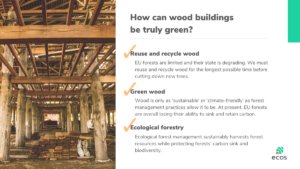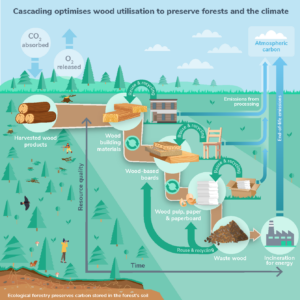Seeing the forest through the trees: how can wood buildings be truly green?
Wood is one of the longest-standing building materials in human history. Although the use of steel, concrete, or iron has brought significant advances to construction, wood is now enjoying newfound popularity.

We can find new iconic wood structures all around the globe: the Swedish cultural centre Sara Kulturhus, one of the world’s tallest wooden buildings and a place where the city’s culture meets; Treet, the wooden high-rise building in Bergen, Norway; the Brock Commons Student Residence at the University of British Columbia in Vancouver; or the Metropol Parasol in Seville, Spain.
Wood not only supports the beauty of architecture but, under the right conditions, it can also be environmentally friendly. Timber buildings can offer a lower embodied carbon solution and a typically long-lasting alternative for carbon storage. A large-scale transition to mass timber buildings, however, does not come without risks: although renewable, forest resources are not infinite, and their management can harm biodiversity. In the context of the double climate and biodiversity crises, this transition must be managed with care.
If used right, wood can help decarbonise the polluting building sector
The building sector represents 50% of all material extraction. Moreover, it produces over one-third of all waste in the EU. This is why the built environment creates significant societal and planetary impacts. Wood does, however, also hold potential in the green transition: reusing old construction timber or using wood from ecological forestry as a structural building material can help us achieve the EU climate targets, and move toward a truly circular bioeconomy.
Used as a structural building material, wood can reduce a building’s emissions by 50% or more compared to conventional materials such as steel and cement. In other words, wood can become a key pillar for low-carbon buildings. That is as long as it is truly long-lasting and does not contribute to climate change and to biodiversity loss from deforestation!
The potential of wood for circularity is huge but mostly untapped, and the impacts of forestry practices are poorly documented. Having said that, we know EU forests are becoming less effective in sequestering carbon due to the increase in harvests and the impacts of hazards such as fires, pests, and droughts. What is more, many other sectors are competing to claim access to this resource.
That is why ECOS is calling on policymakers and standardisers to only support long-lasting uses of wood coming from old construction wood and from ecological forestry. If we want a green transition, forestry and construction must be efficient and sustainable.

Efficiency: the cascading use of wood to preserve forests and climate
The cascading use of wood takes place when the wood is processed into a product, and this product is used several times more for material, until it is incinerated for energy. In other words, we are talking about using wood more efficiently.

Measures such as good maintenance, repair, reuse, and recycling extend the lifespan of wood, avoiding the need for a new product. By doing so, we reduce biodiversity loss and greenhouse gas emissions from making new wood products. When it comes to wood and other biomaterials used in buildings, there is an additional incentive to keep the product in use as long as possible: carbon storage. The longer the wood fibers stay intact, the longer they keep carbon dioxide out of the atmosphere. Let’s delve deeper into the cascading use principle.
Forests absorb carbon through photosynthesis. When we cut trees, this carbon remains stored in the wood. Wood is then transported and processed into structural timber and used in buildings, with some emissions related to the energy used for these processes. Did you know buildings effectively store carbon in wood, potentially for centuries? Of course, it only works as long as the building stands and the wood is not burned or decayed. Wood from buildings can be reused as it is or reprocessed for reuse several times after that and then recycled, which preserves some or all the carbon it contains.
The cascading use principle is a strategy to use biomass resources for the longest time possible. How? By giving wood products multiple lives, and by prioritising wood uses that offer the highest environmental added value – mainly those which preserve the carbon stored in wood rather than release it rapidly. The cascading use principle is a great starting point to lead the conversation on wood circularity and carbon.
Towards ecological forestry for sustainable buildings and a green transition
Ecological forestry is more than planting trees. Forests play multiple roles for society and for nature: filtering the air and water, preventing floods and soil erosion, creating cooler climates and precipitation, providing habitats for species, and a space for human recreation. Forests also provide materials for our economy and contribute to the sinking of carbon from the atmosphere. This is why we need to take care of our forests and only harvest within ecological limits while enhancing forests’ multiple roles.
Ecological forest management might seem like a big step for a forester. However, it is actually a better long-term investment than intensive forestry!
It is simple: once forestry is ecological and circularity is applied, wood becomes truly sustainable. When we use sustainable wood in buildings, this wood contributes to decarbonising the construction sector. That is why European policymakers stand before a unique opportunity for green building and forestry policies, as well as contributing to climate mitigation. The EU must review the different construction sector policies, along with the new frameworks on deforestation and forest degradation, and carbon removals. This includes supporting the use of circular and sustainably sourced wood by the building sector.
For timber buildings to be truly green, we need to focus on our climate goals and… see the forest through the trees.
Read our key points and recommendations HERE.
Find ECOS report HERE.

 By
By  By
By 
